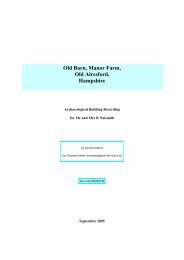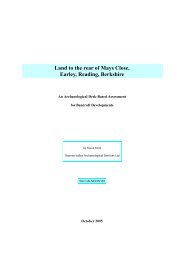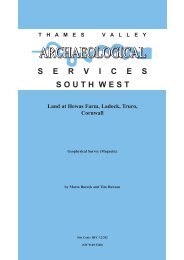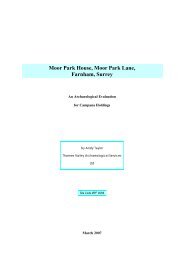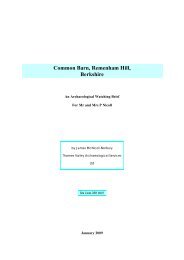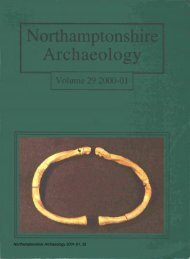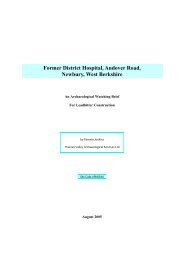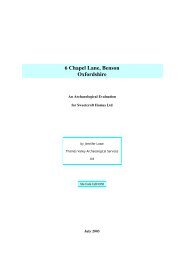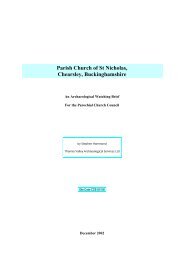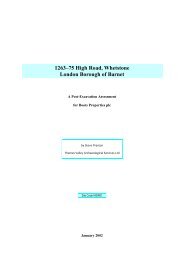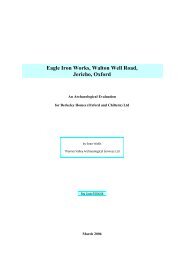Desk-based assessment report - Thames Valley Archaeological ...
Desk-based assessment report - Thames Valley Archaeological ...
Desk-based assessment report - Thames Valley Archaeological ...
You also want an ePaper? Increase the reach of your titles
YUMPU automatically turns print PDFs into web optimized ePapers that Google loves.
To the south-west of All Saints’ Church excavations revealed a probable round house consisting of a<br />
circular set of post holes dating from the late Bronze Age to the early Iron Age. Cropmarks were investigated<br />
during the excavations which were revealed to be a series of linear ditches and a trapezoidal enclosure (Jenkins<br />
1991). In addition six Roman inhumation burials were recorded, dating to the 4th century. The presence of a<br />
Roman villa is also recorded to the north of the town. It is a Scheduled Ancient Monument (SAM 305) and was<br />
partially excavated in 1929 and 1930, which revealed tessellated pavements and a bath suite.<br />
Although the town is thought to have Saxon origins very little evidence for Saxon activity has been<br />
recorded. The only reference to possible Saxon activity is for several sherds of pottery retrieved during work at<br />
the cemetery close to Kings Street have been described as being similar to Anglo-Saxon ‘Portchester’ ware<br />
(Moorhouse 1972)<br />
Work carried out on the site of the castle, located to the north of the town, has revealed an octagonal keep<br />
which was constructed later than the original castle, possibly in the mid 13th century (Barton 1982; Allen 1984;<br />
Barton and Allen 1985). Further investigations to the east Palace Gate produced two sherds of medieval pottery<br />
(Saunders 1995) and work at Palace Gate itself failed to record any finds or features associated with late<br />
medieval royal residence (TWA 1988).<br />
Hampshire Sites and Monuments Record<br />
A search was made of the Sites and Monuments Record (SMR) for a radius of 0.5km around the proposal site in<br />
June 2005. A total of 51 sites and findspots including a selection of listed buildings are recorded for this area. A<br />
full catalogue of the search area comprises 156 listed buildings. The SMR information is summarized as<br />
Appendix 1 and entries are located on Figure 1. Listed buildings (some not included in the SMR) are listed in<br />
Appendix 3.<br />
Prehistoric<br />
A single findspot is listed for the prehistoric period [Fig. 1; 30].<br />
Roman<br />
Findspots of Roman material are listed in the SMR [29, 31].<br />
Saxon<br />
No entries are recorded for the Saxon period in the SMR<br />
5



